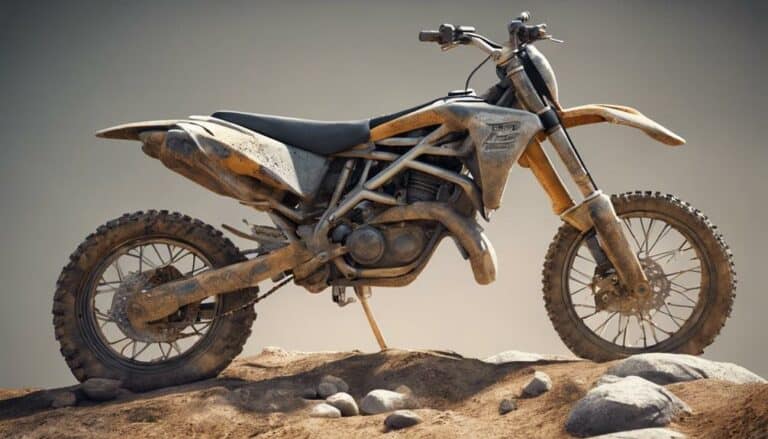When you tackle rough trails on your off-road motorcycle, the terrain plays an important role in determining the gear you should wear. From handling rocky paths to sandy stretches, each terrain type demands specific gear considerations. The right gear choice can enhance your performance and keep you safe during your ride.
So, how does the terrain affect your gear selection? Let's explore the impact of terrain on:
- Helmet selection
- Jacket choices
- Pants selection
- Boot requirements
- The importance of gloves tailored to the terrain you ride on.
Key Takeaways
- Ventilation, impact protection, and peak visors key for hot and dusty terrains.
- Choose jackets with reinforced zones, waterproofing, or insulation based on terrain.
- Pants need breathable designs, waterproof features, and terrain-specific protection.
- Select boots with stiff soles, waterproofing, and versatile features for varied terrains.
Impact of Terrain on Helmet Selection
When selecting a helmet for off-road motorcycle riding, the type of terrain you'll be traversing plays a pivotal role in determining the most suitable features for best comfort and safety. Ventilation is important for hot and dusty off-road terrains to prevent overheating and maintain airflow.
Helmets with peak visors or sun shields are ideal for terrains with intense sunlight, providing protection from glare and enhancing visibility. Opt for lightweight helmets when riding on rugged terrains that demand extended periods in the saddle to reduce fatigue.
For terrains prone to debris or branches, prioritize helmets designed for impact protection and debris resistance to safeguard against potential accidents.
Ensuring the helmet fits securely with goggles is essential for off-road terrains where dust and mud can obstruct vision. Clear vision is paramount for exploring challenging landscapes safely. By considering these factors based on the terrain you'll encounter, you can select a helmet that offers the best combination of comfort, protection, and functionality for your off-road adventures.
Terrain Considerations for Jacket Choice
Consider the specific terrain conditions you'll encounter to select the most suitable jacket for best protection and comfort during off-road motorcycle riding.
For dense vegetation or overgrowth, opt for jackets made with abrasion-resistant materials to prevent snags and tears.
In rocky terrain, prioritize jackets with reinforced impact zones and sturdy construction to shield against sharp edges and impacts.
When facing wet and muddy terrain, choose waterproof jackets with sealed seams and ventilation options for effective maintenance.
Hot and dry desert terrain calls for jackets with ample ventilation, moisture-wicking properties, and sun protection features to ensure comfort and safety.
In snowy or cold conditions, insulated jackets with thermal lining, windproof materials, and adjustable closures are essential to retain body heat and protect against harsh weather.
Pants Selection Based on Terrain
Selecting off-road motorcycle pants tailored to the specific terrain you'll encounter is essential for the best protection and comfort during your rides. When considering the terrain, here are some key points to keep in mind:
- Rocky Surfaces: Opt for off-road pants with durable, reinforced panels to provide added protection for your knees and hips as you navigate rough and rocky terrains.
- Breathable Design: For sandy or hot terrains, choose lightweight off-road pants with ample ventilation to prevent overheating and guarantee breathability.
- Waterproof Features: In muddy conditions, waterproof off-road pants with adjustable closures around the ankles can help keep you dry and comfortable throughout your ride.
Terrain Influence on Boot Selection
In different terrains, your choice of off-road boots plays an important role in providing the necessary protection and functionality for a safe and comfortable riding experience. When considering the terrain you will be riding on, factors like impact absorption, waterproofing, aggressive tread, ventilation, debris resistance, closures, reinforced toe boxes, and versatility come into play. Here is a breakdown of how terrain influences boot selection:
| Terrain Type | Recommended Features | Example Boots |
|---|---|---|
| Rocky/Technical Trails | Stiff soles, ankle protection for stability | Off-Road Boot X |
| Wet/Muddy Conditions | Waterproof, aggressive tread for traction | Off-Road Boot Y |
| Sand Dunes/Desert | Lightweight, breathable, ample ventilation | Off-Road Boot Z |
| Forested/Wooded Areas | Debris-resistant closures, reinforced toe boxes | Off-Road Boot W |
| Varied/Mixed Trails | Versatile balance of protection, comfort, flexibility | Off-Road Boot V |
Selecting the right off-road boots tailored to the terrain you will be riding on ensures you have the necessary features to enhance your riding experience and keep you safe.
Gloves: Terrain-Specific Options
Terrain-specific options for gloves cater to varying off-road riding conditions, providing essential protection and functionality tailored to each environment. When selecting gloves for off-road adventures, consider the following terrain-specific features:
- Rocky Terrains: Look for gloves with reinforced knuckle protection and padded palms. These features help absorb impact and prevent abrasions when traversing rough and rocky terrains.
- Sandy Environments: Opt for gloves with breathable mesh panels and silicone grips. The mesh panels offer ventilation to keep your hands cool, while the silicone grips provide better control in loose and sandy conditions.
- Wet Conditions: Choose waterproof gloves with extended cuffs. These gloves not only keep water out but also maintain grip in slippery and muddy terrains.
Selecting the right gloves based on the terrain can enhance your riding experience by ensuring comfort, protection, and best performance throughout your off-road journey.
Conclusion
When it comes to off-road motorcycle riding, the terrain plays a vital role in determining the right gear for best performance and safety.
As the saying goes, 'gear up for the ride ahead.' By considering the specific challenges presented by rocky, sandy, or muddy terrains, riders can choose the appropriate helmets, jackets, pants, boots, and gloves to guarantee a comfortable and secure riding experience.
Remember, the right gear can make all the difference in tackling any terrain with confidence.

